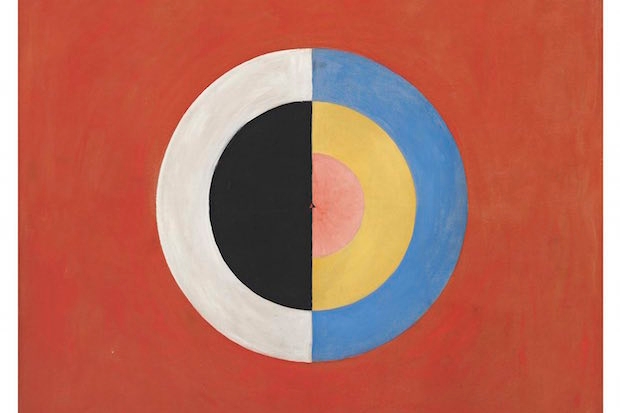In 1896, a group of five young Swedish women artists began to meet regularly in order to access mystical zones beyond the confines of mundane everyday reality. Every Friday, they would gather in order to contact the incorporeal beings they called ‘spirit world leaders’ or ‘High Masters’; among these were five named Ananda, Clemens, Esther, Gregor and Amaliel. In 1904, during a séance, Amaliel instructed one of the artists, Hilma af Klint, to make paintings ‘on the astral plane’ representing the ‘immortal aspects of man’.
Many of the results of this occult commission are on display in Painting the Unseen, a new exhibition at the Serpentine Gallery. As you might expect, they are distinctly weird: an eclectic mélange of geometric shapes, flower and fruit forms, squiggles, diagrams of nothing very specific, shells, numbers and letters, often executed in a slightly dingy pastel palette. By 1908, af Klint (1862–1944) had produced more than a hundred — some over three metres high — and she painted another 82 between 1912 and 1915.
She stipulated in her will that these pictures should not be seen for two decades after her death. In the event, it took even longer: none was exhibited until the 1980s. Since then, art world interest has grown in af Klint, or, more precisely, in these works ‘commissioned’ by Amaliel and apparently at his astral direction. No one has ever been much excited by the more conventional landscapes and portraits by which she made her living. These ‘Paintings for the Temple’, as she termed them, have been claimed as the first European abstractions, predating by several years any such works by Kandinsky, Malevich or Mondrian. The official birth of abstract art is usually dated to 1910.
This raises two questions. Are af Klint’s paintings truly abstract? And, more importantly, are they any good? They certainly have an early modernist look, with sharp outlines and flat areas of colour. Indeed some don’t even appear to be that early; one or two concentric dartboard-like images could have come from New York, circa 1960. Others, however, contain awkward but unmistakable depictions of birds, dogs and naked people.
Af Klint herself doesn’t seem to have had any intention of being avant-garde, or indeed any conscious purpose at all. By her account, these pictures were made ‘through her’, without ‘any preliminary drawings and with great force’. She had no idea what they were supposed to represent, though she spent a lot of time subsequently trying to work it out.
On the other hand, the slightly later works by Kandinsky usually credited as the first abstractions are also full of real objects (most are lightly disguised landscapes). It is also true that the beliefs of Mondrian, Kandinsky and Malevich were only a degree or two less loopy than those of af Klint and her four friends. Around 1900, spiritualism, the mishmash of esoteric doctrines known as theosophy and excursions into what Conan Doyle called ‘the land of mists’ were all part of the zeitgeist.
The crucial point is that judged as paintings, these mystic images just aren’t very good. The brushwork is boring, the drawing a bit slack, the colour harmonies lacking in zing. In comparison, a good Kandinsky is a hugely impressive sight. Being first, chronologically, is perhaps overrated; it’s being better that counts. Af Klint’s mystic pictures were worth exhibiting, and indeed deserve a look, but they are a minor footnote rather than a major rediscovery.
Nearby in Kensington Gardens, at the Serpentine Sackler Gallery, there are works by two German artists, Kerstin Brätsch and Adele Röder, who exhibit together under the collective name Das Institut. Between them, Brätsch and Röder use a variety of media, including painting, neon and stained glass. The unique feature of the show is the way they display their works, sometimes actually piled on top of each other in open crates. Individually, the most striking pieces are Röder’s neon drawings of body parts, such as the outlines of two breasts that the visitor encounters at the start. But the various ingredients are less novel than the way they are jumbled together. Overall, there is an air of cheerful, chaotic muddle.
Over at the Waddington Custot Galleries on Cork Street, there is a fine exhibition of early works by Barry Flanagan (1941–2009), a sculptor whose later output consisted largely of bronze hares. Earlier, however, his work was both varied and audacious, as is demonstrated by the pieces on show, which date from 1964 to 1983.
The young Flanagan seemed preoccupied with an unusual range of qualities, including lightness, thinness and floppiness. Even when in 1964 he made an early work in his teacher Anthony Caro’s trade-mark medium of painted steel, it protruded a wavering rod like the tendril of a vine. Later pieces are made out of cloth, or sheet metal torn and folded as casually as paper. A bronze from 1980 turns and twists like a piece of apple peel. Three beautiful photographs of long grass from 1967 reveal this everyday sight to be as complex and dramatic as a storm at sea. Everywhere you find a unique sensibility at work.
A few minutes’ walk away at Ordovas, 25 Savile Row, there is an intriguing sculptural contrast in the form of three massive works by the Spanish sculptor Eduardo Chillida. Chillida (1924–2002) was an exact contemporary of Caro’s and some of his work belongs to an abstract idiom that might be dubbed heavy metal (a Chillida show at the Hayward a quarter of a century ago was actually publicised as the weightiest ever shown in London). The three works on show at Ordovas — two steel, one stone — certainly have a massive presence. But there is a feeling of growth about them too; one looming, rust-coloured piece extends curved members into the air like the branches of a tree. This little exhibition makes Chillida’s work, still not well-known in Britain, seem formidable.











Comments